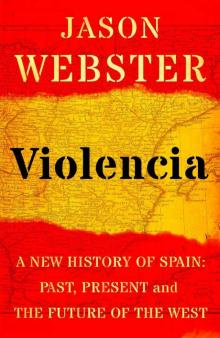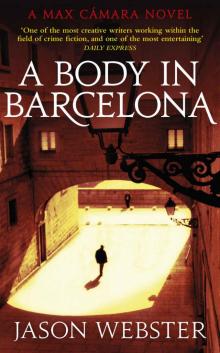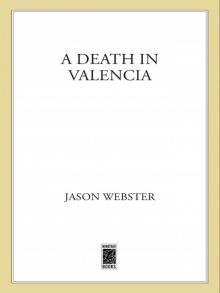- Home
- Jason Webster
Violencia Page 16
Violencia Read online
Page 16
The contrast with his native Spain could not have been greater. More damning insight into a growing suspicion of ‘thought’ and culture at the time comes in a passage Cervantes wrote in one of his Entremeses, in which he asks a villager if he can read. To which the man replies:
‘No, of course not. Nor will it be shown that anyone in my lineage would be so stupid as to learn these chimeras, which lead men to be burnt and women to houses of ill repute.’
Thinking, ideas, the world of books and learning, far from advancing human culture had become dangerous. The examples of Cordoba, Toledo and elsewhere centuries before, movements which had changed the world, were all but wiped from memory. Three hundred years after Cervantes wrote those words, much of Spain would have looked very familiar to him, with rural areas in the early 1900s reporting illiteracy levels of close to 100 per cent. The darkness which the Inquisition ushered in remained in place for a very long time indeed.
With time, the Inquisition became more and more degenerate, while continuing to enjoy popular support. With fewer and fewer heretics to persecute, it busied itself with other matters, such as sexual habits or superstitious beliefs. In contrast to much of the rest of Europe, witchcraft on the whole was ignored, although one famous case, that of Zugarramurdi in 1610, in which six women were condemned to death, stands out. By the eighteenth century the number of executions had diminished; the organisation, now corrupt and decadent, dedicated its energies to persecuting new ‘liberal’ political ideas or policing the import of indecent illustrations and books from abroad. Even wax busts in the windows of hairdressers were targeted, their necklines and cleavages deemed too revealing.
But Spain was changing. Despite its greatest efforts, the Inquisition couldn’t stem the flow entirely of new, Enlightened ideas arriving from across the Pyrenees. The organisation’s last victim was a schoolteacher in Valencia who refused to teach the Catechism. Cayetano Ripoll was executed by hanging in August 1826. In June 1834, the Holy Office was finally abolished.
Yet the Inquisition had left an indelible mark on the country. It was later revived in all but name during the Spanish Civil War, and continued almost to the present day: even as General Franco was dying in late 1975, left-wing nonconformists were being executed on his orders using one of the favoured methods of the Inquisitors, the garrotte.
1 The small Portuguese hill town of Belmonte was the only place on the Peninsula where Jews managed to survive the Inquisition. When, finally, they were discovered in the early twentieth century, it was revealed that one of their survival techniques had been to make fake pork sausages using chicken. Interestingly, the Belmonte Jews thought for a long time that they were the last Jews in the world, having been completely cut off from any other Jewish communities for centuries.
2 The clearest example of how deep his paranoia ran comes with the arrest in 1559 of the very head of the Spanish Church, Cardinal Carranza. Despite being a former persecutor of heretics himself, Carranza was locked up for seventeen years on charges of . . . heresy. He later died in Rome after lengthy trials ended in his absolution.
SCENE TWO
A MIXED PALATE
Spanish cuisine reflects much of the country’s character: its division into multiple parts, its tendency to ‘forget’ its history, its blending of many influences from abroad, and its simultaneous experimentalism and conservatism. As with many cultures, understanding Spanish food goes a long way towards understanding the place itself.
Olives and grapes, staples of a more sophisticated Mediterranean diet, first arrived in the Peninsula from the East with the Phoenicians around three thousand years ago, but cultivation and development were slow and only began to gain importance once the Roman conquest was under way. Spain became, in time, an exporter of garum – a fish sauce much used in the Roman diet – to the rest of the empire, and the remains of an ancient garum factory, where fish entrails were fermented, can still be visited near the southern town of Tarifa. Rome also laid the groundwork for irrigation systems within Hispania, but the real revolution in cuisine and agriculture came with the Moorish invasion of the eighth century.
Hailing from drier climes, the Arabs were nothing if not respectful of water, a fact shown in their frequent use of it in decorative pools and fountains for their gardens. Once established in the Peninsula, they introduced more sophisticated irrigation techniques, as well as new crops which could benefit from the more efficiently tended soil. In the south, water from the Guadalquivir was extended across the flat valley plain, while around Valencia in the east a vast market-gardening area was created around the city which was still providing Spain’s biggest foreign exports earner as late as the twentieth century. Apricots, artichokes, carob, rice, saffron, sugar cane, aubergines, parsnips, lemons, oranges, grapefruit, carrots and spinach were all introduced and cultivated on a mass scale during this period, as their names – almost all of Arabic or Eastern origin in Spanish and English – testify.1 This ‘green revolution’ not only made Spanish food more interesting, but led to something of a population explosion as people began eating far more healthily: the foundations for one of the world’s healthiest diets – the Mediterranean – and the reason why Spain today enjoys some of the highest longevity rates anywhere, can be found in the Moorish period. Indeed, the irrigation network around Valencia has barely changed in a thousand years and is still very much worked by hand, with mounds of earth running in lines in the fields to form mini-barriers which control and divert the course of the water as it enters from the channel running along one side. The legal authority in charge of any disputes – El Tribunal de las Aguas – was set up during the reign of Abd al-Rahman III in the tenth century and still meets every Thursday (the last day of the Islamic working week) at midday outside the cathedral (formerly the site of the city’s main mosque). It is one of the oldest functioning legal institutions in the world and continues an old Berber practice of indicating whose turn it is to speak by pointing with feet rather than fingers. In the Huerta, as the fertile lands are collectively known, you can still hear the elderly using occasional Arabic words, for example ma meaning ‘water’ directly from the Arabic, as opposed to the Castilian agua or Valencian aigua from the Latin aqua.
The rice that was introduced to the Valencia area and grown to the south of the city in the Albufera wetlands, went on to become the most important ingredient, along with saffron, in what is arguably Spain’s national dish: paella. But paella is problematic, for despite having spread across most of Spain to become a staple dish, and even beyond Spanish borders to become a culinary symbol of Spain, argument rages about its accepted ingredients. In typical Spanish style, disagreements on the subject can, at times, become quite vocal and even heated.
On the one side are the purists, defenders of la paella valenciana, the original incarnation of the dish. (At this point I have to put up my hand and admit that my sympathies lie with this particular faction, although I have softened somewhat in my previously paella-fascist stance . . .) Even here there are discrepancies and disputes, but essentially it is made with chicken, rabbit, bachoqueta green beans and garrofón butter beans, along with paprika, tomato, rosemary and Valencian rice. Ordinary household Bahía or the newer Albufera varieties are fine. Food snobs who bang on about more expensive Bomba rice being the best are merely following the example of restaurants, who only use it because it is harder to overcook and therefore more useful in a busy restaurant environment. Hardly anyone uses saffron any more because it is expensive and most of the stuff on sale is fake (marigolds and all kinds of rubbish are packaged up as ‘saffron’ these days). Ordinary Valencian folk use an orange food colourant instead, which is almost 100 per cent tartrazine, and therefore less than ideal from a health perspective. A handful of Valencians are starting to use small amounts of turmeric as a substitute. What almost everyone agrees on, however, is that hard, chalky Valencian water is needed to make real paella. Nothing else will do. A friend who drives every summer from Valencia to Italy to visit his exte
nded family there actually fills the back of his car with containers of tap water just so he can make ‘real paella’ for them once he gets over the border.
Much more could be written about authentic Valencian paella, about how it should be cooked over a fire made using the wood from pine and orange trees, about the finer points of the gooey socarraet at the bottom of the pan where the rice begins to stick, about the permitted use of certain other ingredients depending on the time of year or village in which it is being prepared, such as snails, or cow’s liver . . . But I shall restrain myself.
The argument over authentic paella ingredients is echoed in the debate over its origins. The word ‘paella’, according to the orthodox view, comes from the Latin patella, which was a kind of flat pan. And although this has a ring of truth about it, it fails to embrace the Eastern origins of the dish’s two most important ingredients: rice and saffron. An alternative etymology derives from the Arabic for ‘leftovers’, al-baqiyya, sometimes pronounced al-ba’iyya. It has to be pointed out that neither of the two cookbooks which survive from Moorish times talks about anything like a paella dish existing from that era, and yet anyone who has eaten Persian stuffed-rice dishes will perceive a direct link, not least between the socarraet of paella and the crispy tahdiq of the Eastern equivalent.
Given all these arguments and disagreements, it is perhaps not surprising, then, that paella has become Spain’s de facto national dish. Could we imagine anything else from a nation so divided by internal conflict and warfare?
The veil drawn over any connection between paella and Eastern rice dishes marks a trend, however, and part of one of the major patterns which governs Spanish history – that of periodically ‘forgetting’. As we’ve seen earlier, food was an important signifier of faith in the past, so much so that an emphasis on pork-eating became inevitable as a way of showing oneself not to be either Jewish or Muslim in the paranoid years of the Inquisition. Yet it went further than this. As noted before, olives had been a Spanish crop since Phoenician times, and yet the Inquisition tried – and thankfully failed – to eradicate them from the local diet, considering them Moorish. ‘True’ Christians came from the north of the Peninsula, where they cooked with lard and butter, which were therefore viewed more favourably. Part of the problem possibly lay in the fact that despite having Latin-based words for ‘olive’ and ‘oil’, Spanish had adopted Arabic-based words for them instead: aceituna from al-zeitun, and aceite from al-zeit. Moorish doctors and writers had also extolled their virtues, including the great Averroes, who wrote:
When oil comes from ripe, healthy olives and its properties have not been tampered with artificially, it can be assimilated perfectly by the human body. The quality of fried eggs [and other foods] improves greatly if fresh olive oil of little acidity is used. Generally speaking, all olive oil is excellent for people.
Other ingredients, however, do appear to have vanished from the Spanish kitchen in the wake of the Inquisition’s cultural purges. Unleavened bread was a staple, but was stamped out. Moorish recipes commonly use coriander, yet when I first lived in Spain in the early 1990s, the herb was unknown. It later made a reappearance with the influx of immigrants from Latin America in the 2000s, who unwittingly brought back with them flavours which had originally been Spanish and had travelled with the Conquistadors across the Atlantic in the first place. Another example is couscous, which was very common in Moorish Spain, so much so that it gave birth to the Spanish word alcuzcúz. Yet having been wiped from collective memory by the spirit of the Inquisition, when it made a reappearance in the late twentieth and early twenty-first century in Moroccan bars and restaurants, Spaniards referred to it as el cuscús, unaware that their own dictionaries already had a word for this ‘new’ exotic dish from across the Strait.
There is even a suspiciously Moorish angle to Spain’s obsession with eating pork. Yes, it is permitted by Christianity and forbidden by Islam and Judaism, but in many ways Moorish traditions surrounding lamb appear to have been grafted wholesale on to the unsuspecting pig. As the Spanish today use every conceivable part of the animal in their cooking, even the ears, so Moorish cookbooks recommended the same for lamb, and recipes for it far outweigh those for chicken and beef. And as Muslims ritually slaughter a lamb once a year on the Eid al-Adha festival, so it was common until relatively recently in Spain for every family to kill a pig on the feast of St Martin. Likewise, a dish my wife often makes, arroz con espinacas, could easily come from the Middle East: simply substitute the pork with lamb and add coriander and other spices which disappeared in the past, and you have something recognisable as far away as India. The meat in question has changed, but structurally there are many similarities.2
A similar case of a food falling foul of the political correctness of its times is the humble ensaladilla rusa – ‘Russian salad’ – found in bars practically everywhere across Spain. Made with a variety of ingredients including peas, potato, olives and peppers mixed together with mayonnaise, during the Spanish Civil War it had to be re-baptised in Francoist areas as ensaladilla nacional, as anything ‘Russian’ was considered communist and therefore offensive. Likewise a coffee made with meringue milk known as a ruso had to be called a nacional.
Modern Spain has moved in new culinary directions, most notably with a healthy number of Michelin-starred restaurants and chefs such as Ferrán Adriá who have become international cooking stars. Innovation has been the watchword, and for a while it seemed that all foods, including Spanish standards such as gazpacho and tortilla de patata, were to be converted into concentrated and very small portions of flavoured foam as part of the new culinary wave. Yet despite cities like San Sebastián and Barcelona becoming foodie-meccas, not everywhere has enjoyed the advances in cooking styles and techniques. Andalusian food is generally still very oily, and it is hard to find a non-Andalusian ready to extol the virtues of the cuisine of this southern part of the country. Elsewhere in Spain, for example in the high plains, ‘food’ is almost synonymous with ‘stews’ of varying description, some better than others – hearty meals designed for life at high altitude. Travel across the country, and barring a few notable exceptions, you’d be hard-pressed to identify a single Spanish cuisine at all. Or even a drinking culture: try asking for a fino – a ‘sherry’ – in many areas, particularly in the north, and you will frequently be met by blank stares.
Despite its high-speed trains, its motorways, modern communications and even the Internet, food still divides the Spanish subcontinent as much as it always has.
1 ‘Apricot’ is curious in that the Arabic name ‘al-barquq’ comes from the Latin ‘praecox’, because the tree blossoms early in the year. ‘Praecox’ went on to give us ‘precocious’, while ‘al-barquq’ passed through Spain to become ‘albaricoque’ and in time the English ‘apricot’.
2 In a similar fashion, a Moorish influence helps to explain the common use of ‘Jesús’ as a first name in Spanish- and Portuguese-speaking cultures, a practice almost unheard of elsewhere. When you take into account the many centuries Christian Spaniards spent living side by side with people who frequently named their sons after their prophet, Muhammad, it makes more sense.
PART FOUR
AUSTRIAN SPAIN
THE OUTSIDER
Joined by the marriage of Ferdinand and Isabella, Castile and Aragon were meant to be ruled under a single Spanish-born monarch following their deaths, thereby cementing the union of the crowns. But these carefully laid-down plans were shaken by the joint forces of mental instability and lust: there would eventually be a single king once the Catholic Majesties were gone, though he was anything but Spanish.
The original heir to the throne was the couple’s second-born son, Prince Juan. Juan, however, married Margaret of Austria who, in the space of a few months, had despatched the unfortunate nineteen-year-old to the next world through an excess of marital congress.
‘We should give him a rest,’ alarmed court medics had warned Isabella. ‘Such frequent copulation is
harming the prince’s health.’
But his mother wouldn’t hear a word of it.
‘Men cannot separate those whom God has joined in conjugal union.’
And so the shagged-out crown prince breathed his last.1
Juan had a sister, named after their mother, but she died shortly afterwards as well. Which left the young Princess Juana. Some at the time thought her quite capable of taking the reins of power. But they were wrong: Juana was, in fact, a basket case, remembered by history as la Loca – ‘the Mad’. As a girl she had displayed excessive mood swings and extreme hypochondria. She married Philip ‘the Handsome’, son of the Holy Roman Emperor, and bore six children, but with each birth her mental health deteriorated, worsened by a growing obsession over Philip’s infidelities. When her husband died suddenly at the age of twenty-eight (some say poisoned by his father-in-law, Ferdinand) Juana became so unstable that she was removed from power. For the rest of her life she was effectively imprisoned at Tordesillas, dying at the age of seventy-five in 1555, having barely reigned a day.
Some have questioned Juana’s madness, suggesting that her father made out that she was mentally unstable to further his own political ends. But her mother’s will, written as she was dying of uterine cancer in 1504, suggests that there were doubts about Juana from the start: Isabella passed the crown of Castile to her daughter, but added the proviso that should she be incapacitated, her father should act as regent until Juana’s son, Carlos, came of age.
Ferdinand certainly had an eye on the Castilian crown, now further enriched by the treasures beginning to arrive from the New World. But such were the rivalries and historic tensions between Aragon and Castile that he was unable to take on the role of regent he desired. So divided was ‘Spain’ even at this point after decades of joint rule by the Catholic Monarchs that the idea of an Aragonese king ruling over Castilians was unthinkable. And so Cardinal Cisneros took the position instead. Still, however, Ferdinand thought he might secure the joint throne for his own Spanish offspring, and married a Frenchwoman, Germana de Foix, in an attempt to produce a new heir. But his efforts not only proved fruitless, they killed him. Already in his sixties, Ferdinand relied too much on the Viagra of the moment for his project, potions made from the emerald-green beetle Lytta vesicatoria, known as Spanish Fly. A highly toxic substance, the ‘aphrodisiac’ causes severe gastrointestinal bleeding, renal failure and eventual death.

 Violencia
Violencia Or the Bull Kills You
Or the Bull Kills You The Killing of El Niño Jesús
The Killing of El Niño Jesús The Spy with 29 Names
The Spy with 29 Names Duende
Duende Guerra
Guerra Sacred Sierra
Sacred Sierra A Body in Barcelona: Max Cámara 5
A Body in Barcelona: Max Cámara 5 Fatal Sunset
Fatal Sunset A Death in Valencia
A Death in Valencia Blood Med
Blood Med Andalus
Andalus